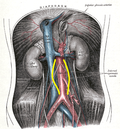Abdominal aortic aneurysm
Abdominal aortic aneurysm (AAA or triple A)[1] is an enlargement of the abdominal aorta which is more than 50% larger than normal.[2] They usually cause no symptoms, except during rupture. This may cause abdominal, back, or leg pain.[3] Large aneurysms can sometimes be felt by pushing on the abdomen.
Rupture may result in pain in the abdomen or back, low blood pressure, or loss of consciousness and can cause death.[4]
Abdominal Aortic Aneurysm Media
A plate from Gray's Anatomy with yellow lines depicting the most common infrarenal location of the AAA
Aortic measurement on abdominal ultrasonography in the axial plane between the outer margins of the aortic wall
Ultrasonography in the sagittal plane, showing axial plane measure (dashed red line), as well as maximal diameter (dotted yellow line), which is preferred
Ultrasound showing a previously repaired AAA that is leaking with flow around the graft
References
- ↑ Logan, Carolynn M.; Rice, M. Katherine (1987). Logan's Medical and Scientific Abbreviations. Philadelphia: J. B. Lippincott Company. p. 3. ISBN 978-0-397-54589-6.
- ↑ Kent KC (27 November 2014). "Clinical practice. Abdominal aortic aneurysms". The New England Journal of Medicine. 371 (22): 2101–8. doi:10.1056/NEJMcp1401430. PMID 25427112.
- ↑ Upchurch GR, Schaub TA (2006). "Abdominal aortic aneurysm". Am Fam Physician. 73 (7): 1198–204. PMID 16623206.
- ↑ Spangler R, Van Pham T, Khoujah D, Martinez JP (2014). "Abdominal emergencies in the geriatric patient". International Journal of Emergency Medicine. 7 (1): 43. doi:10.1186/s12245-014-0043-2. PMC 4306086. PMID 25635203.








